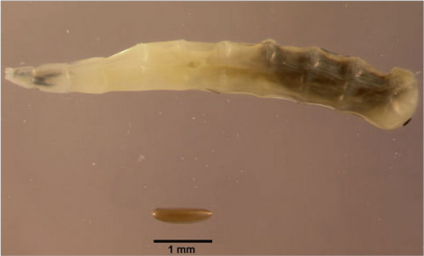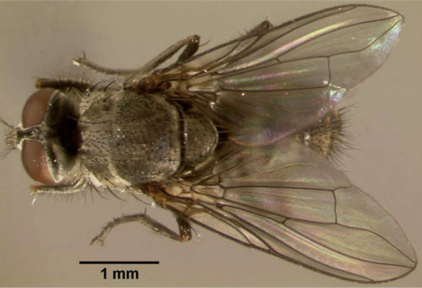Haematobia irritans (Linnaeus)
Author: Nancy Hinkle, Extension Veterinary Entomologist, University of Georgia, 2021
Description
Immature stages: Eggs are tan, yellow or white then turn into a reddish-brown color prior to hatching. Eggs are oval and concave on one side and convex on the other, approximately 1.2 mm long. Newly hatched maggots are white, about 1.5 mm long with a slender pointed head. The spiracles, or openings for breathing, appear as black indentations at the end of the abdomen.Pupae are 3-4 mm long and white at first, the outer pupal covering hardens, turning dark reddish-brown over several hours.
Adult stages: Adults have brownish-gray or black bodies and are shiny, with slightly overlapping wings held flat over the abdomen. Body is 3.5 to 5 mm long, about half the size of the common house fly, Musca domestica Linnaeus. The head has small, brownish-red antennae that point downward. The thorax has two parallel stripes on the dorsal surface behind the head. Both male and female horn flies have piercing-sucking mouthparts and feed exclusively on blood.


Biology
Life Cycle: Female flies leave the host only to lay their eggs in manure that is ten minutes old or less. Each lays about ten eggs per trip in as little as a minute. With a lifespan of around two weeks, each adult female can lay over two hundred eggs. Eggs hatch within two days, and the larvae live in the pats for a week until they pupate. They stay in this pupal stage for another week before emerging as adults. If cold weather is approaching, these pupated flies will not emerge, but will stay in the ground and emerge once warm weather returns, resulting in their dramatic spring appearance in pastures. In regions with mild winters, a low number of flies may live through the winter. Horn flies can travel up to three miles in search of host herds, and will settle for a horse, goat, or dog, but are thought to only be able to thrive on cattle, water buffalo, or bison. They rest on the cow with head pointed down, on the back, flanks, and withers of the animal. During the heat of the day they move to the underside of the cow and can be harder to spot.
Distribution: The horn fly is one of the most economically important pests of cattle worldwide, but in the U.S. over a billion dollars annually in losses are attributed to this single irritating insect. It was introduced to North America from France in 1887, and is now found throughout the Americas, Europe, Asia, and the non-tropical regions of Africa.
Damage
Horn flies are commonly reported on beef cattle in large numbers, with thousands of flies occurring on individual animals. Cattle expend a great degree of energy in defensive behavior which results in elevated heart and respiratory rates, reduced grazing time, decreased feeding efficiency and reduced milk production in cows,which can result in decreased weaning weights. Extensive horn fly feeding can also severely damage cattle hides, which results in poorer quality leather. The sheer numbers of flies infesting an animal can result in substantial blood loss. The horn fly is also a vector of several pathogens. A filarial nematode, Stephanofilaria stilesi Chitwood, causes stephanofilariasis, a dermatitis characterized by areas of crusted skin on the underside of cattle. Horn flies also are able to vector several Staphylococcus spp. bacteria, which cause mastitis, or infection of the teats in dairy cows, particularly in summer months. Additionally, flies can introduce the bacteria into open wounds, causing significant infection.
Management
Thresholds have been established based on the numbers of horn flies per animal to determine whether fly management is economically necessary. Calves and dairy cattle cannot sustain high numbers of flies without sustaining measurable damage; 50+ flies per lactating dairy cow is considered to be of economic importance. Beef cows can tolerate up to 200 flies per animal, while bulls can tolerate the greatest number of horn flies. The herd should be checked weekly and once the average number of horn flies per animal is exceeded, control efforts need to be ramped up.
- Insecticidal Ear Tags are a very efficient and long-term means of protecting against flies. All insecticide impregnated ear tags currently marketed are labeled for use against horn flies and claim 3-5 months efficacy.
- Dust bags are an option that can be hung in gateways or any other forced-use location the cattle have to pass through. Pesticide dust inside the bags will coat the animals’ backs but regular maintenance and repeated applications are required to be effective.
- Pour-ons are effective for up to five weeks and are poured down the backline of the cow, with volume calculated based on the animal’s weight.
- Sprays can be used in hand-held spray guns or mist blowers. Some products last about the same amount of time as pour-ons.
- Oral larvicides have not shown as much success as the adult control methods previously listed, but have helped cut down on the larval stages of horn flies in manure. Prepared feed, feed additives, and mineral licks or mixes are all available and pass through the cow into the dung to control the larval stages that develop in the pat. Larvicides have no effect on adult flies.
- Natural control methods are available but do not adequately control horn flies on their own. Parasitic wasps and dung beetles can help reduce horn fly survival, as can manual breaking up of dung pats to dry out the larvae.
Due to their rapid reproductive rate and short generation time, the issue of pesticide resistance is very relevant to horn flies. The three classes of insecticides registered for fly control are organophosphates, pyrethroids, and macrocyclic lactones. In order to prevent resistance, the kind of pesticide used needs to be changed every two or three years.
Macrocyclic lactones, organophosphates, and pyrethroids impair the horn fly’s nervous system, but do so by affecting different pathways. Rotating use of products in these three classes can delay onset of resistance and prolong their effectiveness. It is also important to remove dust bags, back rubbers, and ear tags at the end of fly season.
Additional Resources
Modified from UF IFAS Extension Horn Fly Publication
